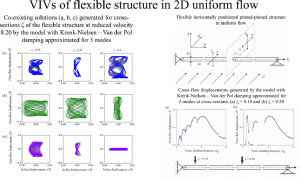International Journal of Engineering Science ( IF 5.7 ) Pub Date : 2020-03-19 , DOI: 10.1016/j.ijengsci.2019.103211 Victoria Kurushina , Ekaterina Pavlovskaia , Marian Wiercigroch

|
The paper investigates Vortex-Induced Vibration (VIV) of a horizontal flexible structure with pinned-pinned ends in uniform flow. The fluid – structure interaction is modelled using the wake oscillator approach to describe fluctuations of the fluid forces based on the results, previously reported by Pavlovskaia et al. (2016), Postnikov (2016), and Kurushina et al. (2018). New two-dimensional wake oscillator models are developed in this study employing a number of alternative damping types in the fluid equation. The proposed models are calibrated with the published experimental data by Sanaati and Kato (2012), for VIV of a horizontal flexible structure for the middle cross-section. The calibration is performed with the focus on the maximum of the observed displacement amplitude in the cross-flow direction. One of the models having the Van der Pol – Krenk–Nielsen damping allowed achieving the lowest objective function during the calibration and, hence, was selected for the detailed analysis in 3 and 5 mode approximations. The dynamics of this model is considered in terms of the time histories, changes in the standard deviations of the modal coefficients along the reduced velocity range and frequency response. Also, a comparison with the alternative model versions in terms of the displacements generated at different locations is provided.
In contrast to the previous findings by Kurushina et al. (2018) for VIV of rigid structures, for the flexible structures it was found in this study that both Van der Pol and Rayleigh damping types appear to be applicable for the VIV prediction. A detailed consideration of the 3 mode approximation of the Krenk–Nielsen – Van der Pol model reveals a presence of co-existing solutions in a number of regions of the reduced velocity. They are present in short ranges of reduced velocity in between the lock-in peaks of the in-line displacement coefficient of the first mode. Modulations and co-existing solutions in the in-line modal coefficients make the in-line displacement prediction challenging while the cross-flow displacement amplitudes are described reasonably well by the proposed models.
中文翻译:

二维均匀流中的柔性结构的VIV
本文研究了具有均匀流动的固定销钉端部的水平柔性结构的涡激振动(VIV)。Pavlovskaia等人先前报道,使用唤醒振荡器方法对流体-结构相互作用进行建模,以基于结果描述流体力的波动。(2016),Postnikov(2016)和Kurushina等人。(2018)。在这项研究中开发了新的二维尾波振荡器模型,在流体方程中使用了许多替代阻尼类型。对于中间横截面的水平柔性结构的VIV,使用Sanaati和Kato(2012)的已发布实验数据对提出的模型进行了校准。校准的重点是在横流方向上观察到的位移幅度的最大值。其中一种具有Van der Pol – Krenk–Nielsen阻尼的模型允许在校准过程中实现最低的目标函数,因此,选择以3和5模式近似进行详细分析。根据时间历史,模态系数的标准偏差沿减小的速度范围和频率响应的变化来考虑该模型的动力学。此外,在不同位置产生的位移方面与替代模型版本进行了比较。沿减小的速度范围和频率响应,模态系数的标准偏差会发生变化。此外,在不同位置产生的位移方面,与替代模型版本进行了比较。模态系数的标准偏差沿减小的速度范围和频率响应变化。此外,还提供了在不同位置产生的位移方面与替代模型版本的比较。
与Kurushina等人的先前发现相反。(2018)对于刚性结构的VIV,对于柔性结构,在这项研究中发现Van der Pol和Rayleigh阻尼类型似乎都适用于VIV预测。对Krenk–Nielsen – Van der Pol模型的3模式逼近的详细考虑表明,在许多速度降低的区域中都存在共存解。它们存在于第一模式的串联位移系数的锁定峰之间的减小的速度的短范围内。在线模态系数中的调制和共存解决方案使在线位移预测具有挑战性,而所提出的模型合理地描述了错流位移幅度。











































 京公网安备 11010802027423号
京公网安备 11010802027423号